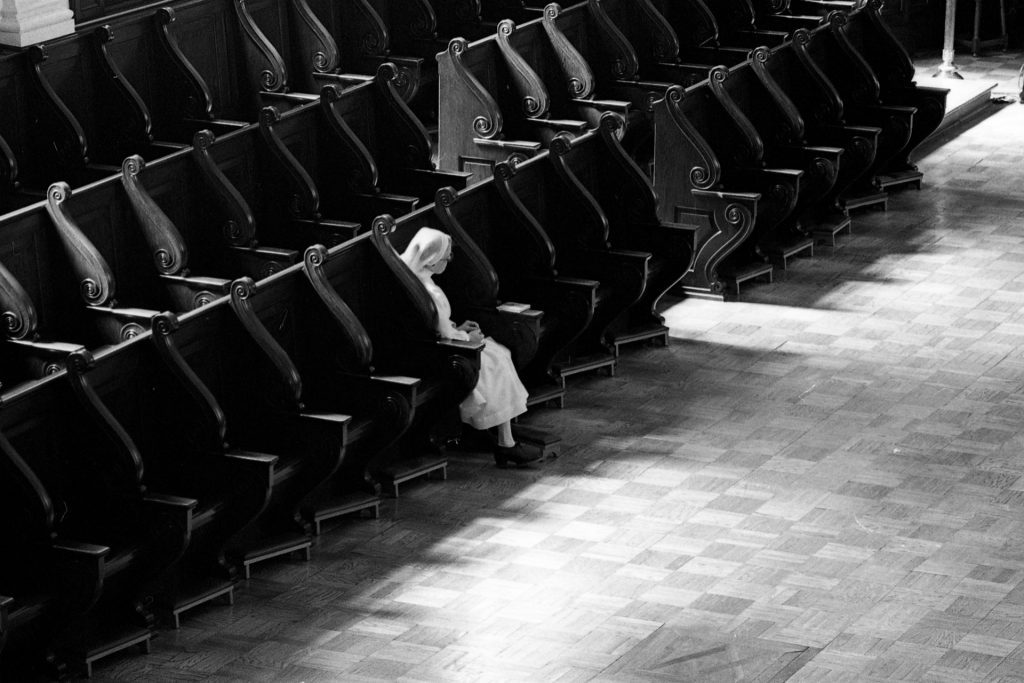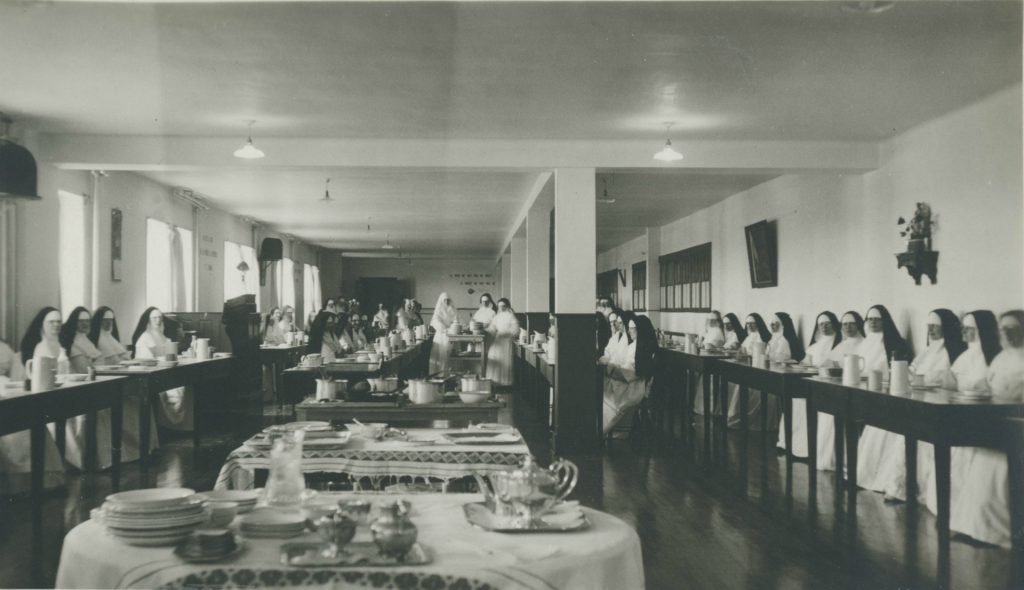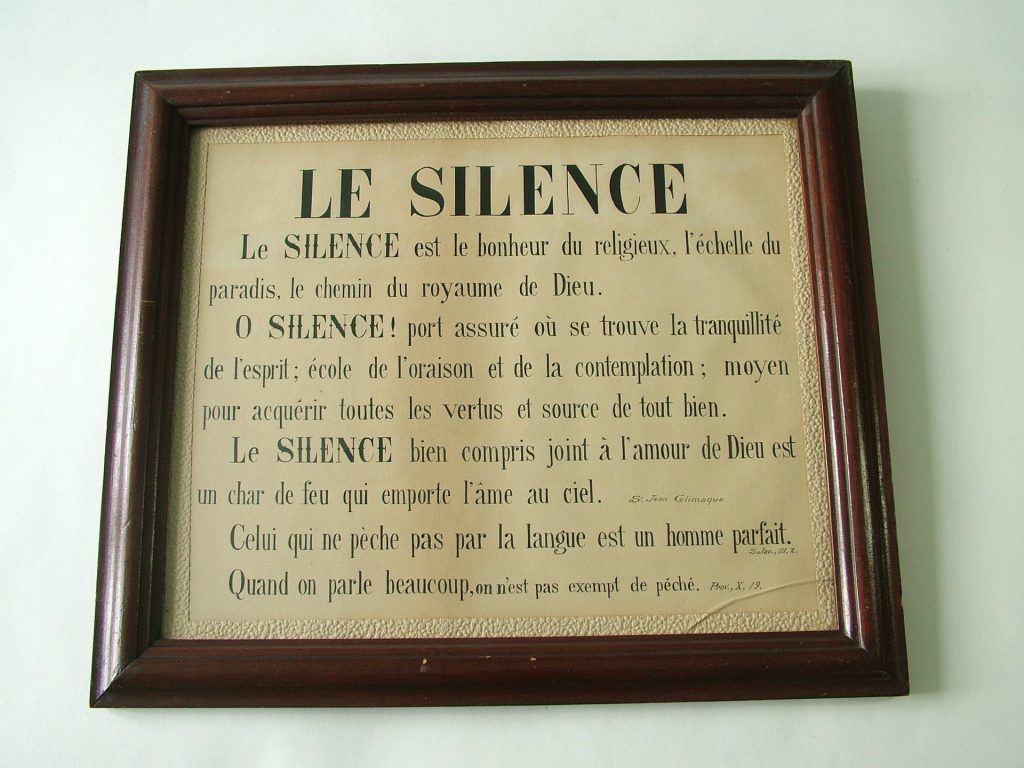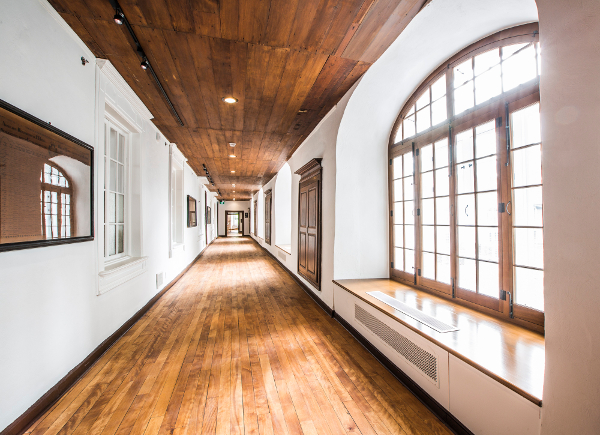The legacy of silence
At Le Monastère des Augustines, we have the privilege and responsibility to preserve and enhance the material, immaterial, social and spiritual heritage of the Augustinian Sisters. Since silence has settled in Le Monastère in thin layers for more than 375 years, we recognize it as a paradoxically immaterial legacy, but one that is tangible. We are constantly seeking ways to translate this legacy and modernize it in our modes of hospitality, our modalities of animation and our programming.

Fonds privé Pierre Bernier.
© Archives du Monastère des Augustines
The Augustinians Sisters, followers of silence
The Augustinian Sisters lived semi-cloistered until 1965 since they worked with the sick; however, in their monastic and community life, they retreated from the noise and activities of the secular world.
For the Augustinian Sisters, hospitality and care are still maintained today by their inner lives, which call for silence and contemplation. Their rules of life determine the times and places devoted to the latter. For example, on certain days or time of the year, during their group meal in the refectory, silence is punctuated by readings.
An Augustinian sister told us that beyond the rules governing silence, it is much more than just the absence of speech, it is a highly-valued intimate experience. Being silent, she says, is much more about listening than being quiet. She speaks of experiencing silence that favours self-discovery, mutual appreciation and valuing the sacred. Silence becomes an ally of inner peace, creating an atmosphere of peace conducive for contemplation, meditation, concentration and rest.

Nuns in the refectory of the monastery of Hôtel-Dieu de Saint-Vallier de Chicoutimi, around 1930. On the wall, at the end of the room, reads a quote from Saint Fraçois de Sales: “Le bruit ne fait pas de bien, le bien ne fait pas de bruit[1]” (HG-A-26.12.4.6.16)
Fonds Monastère des Augustines de l’Hôpital Général de Québec
© Archives du Monastère des Augustines
Silence: a common good to preserve
The Augustinian Sisterss maintain silence in two forms: inner silence and that which they call “silence of action.” This silence of action entails slowing down, being careful not to make noise and murmur if necessary. An Augustinian sister refers to this silence as a common good to be preserved. In the wake of ecological concerns that befall our society, silence can have a political aspect, just like the preservation of endangered animal species!
Silence and keeping your word
Those who visit Le Monastère des Augustines describe that the place itself embodies silence and peace. Although we try to preserve the spirit of Le Monastère’ site, the diversity of its services, its accessibility, its mixed use and visitor needs cause our neo-monastery to not be completely silent. For silence not to be experienced as a constraint—even if it is presented as virtuous—we rather offer an experience of inner silence. We try to offer means that provide our visitors with a state of calm and a slow pace conducive for inner silence. There is only one exception. We have the audacity to invite our guests to a breakfeast in silence. This choice, while paying tribute to Augustinian traditions, allows visitors to experience something truly extraordinary and explore the meaning of silence for themselves.

This sentence regarding silence is today hanging in the old vestibule, behind the ancient tour’s lobby.
© Collections du Monastère des Augustines
Silence: back to the source
Alain Corbin, in his book A History of Silence, which was published originally in 2016, dates back to the 16th and 17th centuries to better understand the scope of silence:
“Silence then was wealth, that of soul-searching and introspection. For Catholics, silence was all about prayer and listening to God. However, in the eighteenth and nineteenth centuries, with the triumph of romanticism and the sensitive soul, there was a true abundance of silence. (…) The silence of the mountains, the desert, the sea, the countryside and love speak to each other, although they didn’t say much to each other in the seventeenth century. “
Silence of benevolence
Thanks to this long-standing history of silence, we have reintroduced silence in our activities so that visitors can experience something truly significant for them. However, this silence is not meant to be strict or all-consuming.
In fact, we notice that Le Monastère’s atmosphere has an effect on many visitors: people speak quietly, walk quietly and move more calmly. It’s often with joy that one agrees to stay in a room without a television and telephone in an authentic or contemporary setting.
Our Movement and Wellness activities rely on silence to foster a sense of being in the present and tranquility. Retreats of a few days are also a special place for silence.

Silence concerts
Inspired by the fraternal and spiritual lives of the Augustinian Sisters, we developed a unique activity: silence concerts. These are events where people come together to remain silent—together. These concerts can only exist if it becomes a common goal and for a common good. The distinctive character of this silence, besides its collective aspect, is that everyone is invited to dedicate their silence to a person or a cause. This dedication ensures that the silence created individually, collectively and fraternally gains in depth. This experience of ephemeral, yet collective, silence is the kind that helps people take care of themselves and others—and encourages everyone to adopt the legacy of the Augustinian Sisters.
***
In 2019, Le Monastère’s team will pay close attention to silence part of our activities. We will continue the Augustinians’ legacy of silence in a creative and contemporary way. Let’s keep our words and do silence together.
Claudine Papin
Social Heritage Advisor
[1] “Noise does no good, Good makes no noise.”

